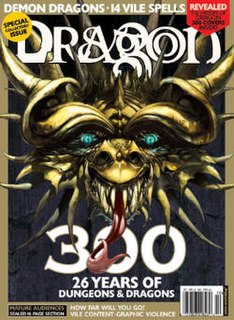
Dragon is one of the two official magazines for source material for the Dungeons & Dragons role-playing game and associated products, along with Dungeon.

Dungeon was one of the two official magazines targeting consumers of the Dungeons & Dragons role-playing game and associated products; Dragon was the other.

Wizards of the Coast LLC is an American publisher of games, primarily based on fantasy and science fiction themes, and formerly an operator of retail stores for games. It is currently a subsidiary of Hasbro, which acquired the company in 1999. During a February 2021 reorganization at Hasbro, Wizards of the Coast became the lead part of the new "Wizards & Digital" division.
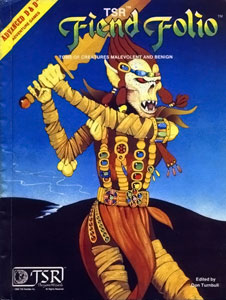
Fiend Folio is any of three products published for successive editions of the fantasy role-playing game Dungeons & Dragons (D&D). All three are collections of monsters.
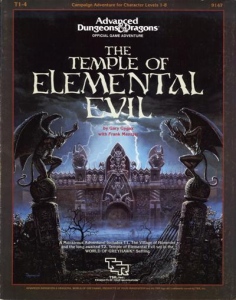
The Temple of Elemental Evil is an adventure module for the fantasy role-playing game Dungeons & Dragons, set in the game's World of Greyhawk campaign setting. The module was published by TSR, Inc. in 1985 for the first edition Advanced Dungeons & Dragons rules. It was written by Gary Gygax and Frank Mentzer, and is an expansion of an earlier Gygax module, The Village of Hommlet. The Temple of Elemental Evil is also the title of a related 2001 Thomas M. Reid novel and an Atari computer game.

Ravenloft is an adventure module for the Dungeons & Dragons (D&D) fantasy role-playing game. The American game publishing company TSR, Inc. released it as a standalone adventure booklet in 1983 for use with the first edition Advanced Dungeons & Dragons game. It was written by Tracy and Laura Hickman, and includes art by Clyde Caldwell with maps by David Sutherland III. The plot of Ravenloft focuses on the villain Strahd von Zarovich, a vampire who pines for his lost love. Various story elements, including Strahd's motivation and the locations of magical weapons, are randomly determined by drawing cards. The player characters attempt to defeat Strahd and, if successful, the adventure ends.
The RPGA, was initially part of the organized play arm of TSR, Inc and later of Wizards of the Coast. From 1980 to 2014, it organized and sanctioned role-playing games worldwide. In 2014, it was replaced with the D&D Adventurers League.
Ralph Williams, almost always referred to as Skip Williams, is an American game designer. He is married to Penny Williams, who is also involved with the games industry. He was the co-creator of Dungeons & Dragons 3rd Edition and the longtime author of the "Sage Advice" column for Dragon Magazine.

Unearthed Arcana is the title shared by two hardback books published for different editions of the Dungeons & Dragons fantasy role-playing game. Both were designed as supplements to the core rulebooks, containing material that expanded upon other rules.
James Daniel Lowder is an American author and editor, working regularly within the fantasy, dark fantasy, and horror genres, and on tabletop role-playing games and critical works exploring popular culture.

Mordenkainen's Fantastic Adventure by Robert J. Kuntz and Gary Gygax is an adventure module for the Dungeons & Dragons role-playing game, published by TSR, Inc. in 1984. It originally bore the code "WG5" and was intended for use with the Advanced Dungeons & Dragons first edition rules. Because it is one of the WG modules, it is a module intended for the World of Greyhawk campaign setting. It was later updated in 2004 to the Third Edition Revised rules in Dungeon magazine, issue #112, as Maure Castle. There were subsequently two additional installments in issues #124 and #139.
Winter Fantasy is an annual gaming convention that takes place in the USA every January or February.
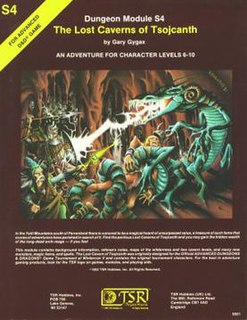
The Lost Caverns of Tsojcanth is an adventure module for the Dungeons & Dragons fantasy role-playing game. It was written by Gary Gygax and published by TSR in 1982 for the first edition Advanced Dungeons & Dragons (AD&D) rules. The 64-page adventure bears the code "S4" and is set in the Greyhawk campaign setting. It is divided into two parts, a 32-page adventure, and a 32-page booklet of monsters and magic items. The plot involves the player characters investigating rumors of lost treasure. After traversing a wilderness and two levels of dungeons, the players face Drelnza, the vampiric daughter of long-deceased archmage Iggwilv.

Stan! is an American author, cartoonist, and game designer. He is sometimes credited as Stan Brown.
Paizo Inc. is an American role-playing game publishing company based in Redmond, Washington, best known for the tabletop role-playing game Pathfinder. The company's name is derived from the Greek word παίζωpaizō, which means 'I play' or 'to play'. Paizo also runs an online retail store selling role-playing games, gaming aids, board games, comic books, toys, clothing and other products, and has an Internet forum community.
Maure Castle is a fictional location in the World of Greyhawk setting for the Dungeons & Dragons fantasy role-playing game. Maure Castle is a massive castle and dungeon complex located in the Duchy of Urnst.

Dragons of Despair is the first in a series of 16 Dragonlance adventures published by TSR, Inc. (TSR) between 1984 and 1988. It is the start of the first major story arc in the Dragonlance series of Dungeons & Dragons (D&D) role-playing game modules, a series of ready-to-play adventures for use by Dungeon Masters in the game. This series provides a game version of the original Dragonlance storyline later told in the Dragonlance Chronicles trilogy of novels. This module corresponds to the events told in the first half of the novel Dragons of Autumn Twilight by Margaret Weis and Tracy Hickman. Its module code is DL1, which is used to designate it as the first part of the Dragonlance adventure series.
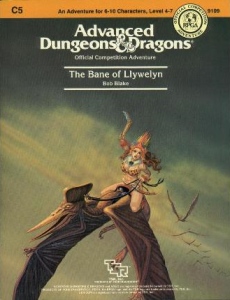
The Bane of Llywelyn is an adventure module for the first edition of the Advanced Dungeons & Dragons fantasy roleplaying game. The adventure was written by Bob Blake and published by TSR in 1985 as part of the Competition, or C-series of modules, and contains material first used in a tournament adventure at GenCon XVI. C5 The Bane of Llywelyn continues the story that started in C4 To Find a King.
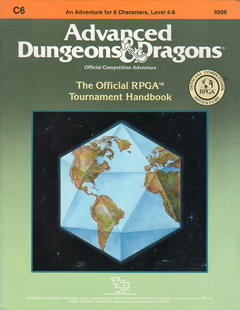
The Official RPGA Handbook is an adventure module for the Dungeons & Dragons fantasy role-playing game, set in the game's World of Greyhawk campaign setting. TSR, Inc. published the module in 1987 for the first edition Advanced Dungeons & Dragons rules. It is part of the "C" series of modules, a set of unrelated adventures originally designed for competition play.













